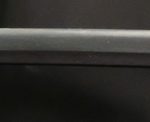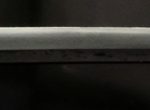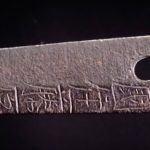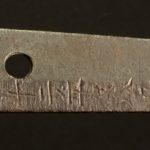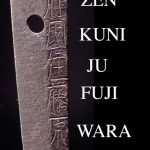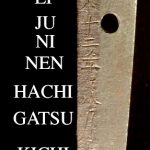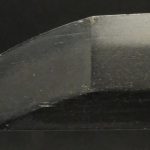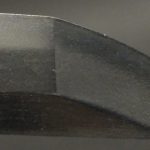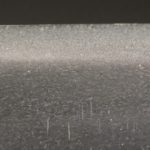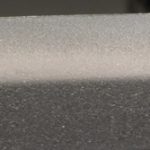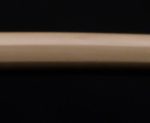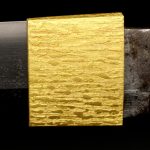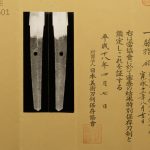HIZEN TADAHIRO
TADAHIRO
NIDAI
WAKIZASHI
NBTHK TOKUBETSU HOZON
O-WAZAMONO
JOJO-SAKU
SUGATA: SHINOGI ZUKURI
MEI: HIZEN no KUNI JU FUJIWARA TADAHIRO
DATE: KANEI JU NI NEN HACHI GATSU KICHI JITSU (1636)
NAGASA: 19.3125″
OVERALL: 24.75″
MIHABA: 1″
KASANE: 0.24″
SORI: 0.4375″
NAKAGO: UBU
MEKUGI ANA: ONE
YASURIME: KIRI
MUNE: IORI
HADA: KONUKA
HAMON: KO-MIDARE BASED ON SUGUHA
BOSHI: KOMARU
HORIMONO OMOTE: NONE
HORIMONO URA: NONE
HABAKI: 1 PC. GOLD PLATE
SHIRASAYA
This is a very elegant wakizashi by the Nidai Hizen Tadahiro. Long swords were signed tachi-mei while wakizashi and tanto were signed katana mei. This sword is signed Hizen no Kuni Ju Fujiwara Tadahiro and is dated Kanei Ju Ni Nen Hachi Gatsu Kichi Jitsu or a lucky day in August, the twelfth year of Kanei era. This was prior to him receiving the “Omi no Daijo” title in Kanei 18 (1641). There are mei dated as far back as 1630 and he died at age 80 in 1693 indicating a long and productive career spanning over 50 years.
The sword is in good polish and condition with no flaws whatsoever. It comes in a high quality custom shirasaya and is accompanied by a NBTHK Tokubetsu Hozon Kanteisho.
Courtesy of Sesko’s, Swordsmiths A-Z:
TADAHIRO (忠広), 2nd gen., Keian (慶安, 1648-1652), Hizen – “Hizen no Kuni-jū Fujiwara Tadahiro” (肥前国住藤原忠広), “Ōmi no Daijō Fujiwara Tadahiro” (近江大掾藤原忠広), “Hizen no Kuni-jū Ōmi no Daijō Fujiwara Tadahiro” (肥前国住近江大掾藤原忠広), “Hizen no Kuni Tadahiro” (肥前国忠広), “Tadahiro” (忠広), real name Hashimoto Heisakurō (橋本平作郎), he adopted later the hereditary name Shinzaemon (新左衛門), son of the 1st gen. Tadayoshi (忠吉) who had changed his name later to Tadahiro, he signed throughout his entire career with Tadahiro and never with Tadayoshi, he received the honorary title Ōmi no Daijō on the 22nd day of the seventh month Kan´ei 18 (寛永, 1641) and died in the 27th day of the fifth month Genroku six (元禄, 1693) at the age of 80, we know date signatures from the seventh year of Kan´ei (1630) to the early Genroku era (1688~ ), that means he was active for more than 50 years and therefore also very productive, his blades show different shapes like a wide mihaba with an ō-kissaki or also a ko-kissaki in combination with a shallow sori, the jigane is a dense and beautifully forged ko-itame with ji-nie which appears as konuka-hada but can also stand-out more noticeable, the hamon is a chū-suguha, notare mixed with gunome-ashi, chōji-midare or gunome-midare, the nioiguchi is mostly wide and the ko-nie are very evenly distributed along the nioiguchi, in the case of a chōji the yakigashira are roundish and long ashi appear, at a gunome, often two gunome are combined, the bōshi is sugu with a ko-maru-kaeri but can also be in midare-komi, contrary to the 1st and 3rd gen., his kaeri runs back a little longer, some blades show horimono engraved by Yoshinaga (吉長), the signature is a tachi-mei at long swords and a katana-mei at wakizashi and tantō, katana measuring just under 2 shaku were considered as ō-wakizashi and were therefore signed with a katana-mei, ō-wazamono, jōjō-saku
Courtesy of Fujishiros:
TADAHIRO ÔMI NO DAIJÔ [KEIAN 1648 HIZEN] SHINTÔ JÔJÔSAKU
He is called Shinzaemonnojô, and he assumed the name of Tadahiro after his father died in Kan’ei Kyûnen (1632). He was 19 years of age at the time. He received the title of Ômi no Daijô in Kan’ei Jûhachinen (1641), and he left behind works over a span of 60 years, until he died of old age at the age of 80 on Genroku Rokunen (1693) Gogatsu Nijûhachinichi (5/28). These works are katana and wakizashi of a good form, the hamon is chû-suguba without any variations, and there are chû-sugu kuichigai ha. There are also midare ha and notare ha with nie nioi fukai in the yaki tani, which is peculiar to Hizen. Rarely, there is a horimono of kenmakiryû, and these were made by Yoshinaga. (Ôwazamono)
This sword comes with a 48-hr. inspection period.
Please refer to the Policy Page for complete details.
A gorgeous sword by an outstanding smith from one of the most prestigious schools on the Shinto period. The sword is much nicer than the photos reveal.
$7500 plus S/H and any additional associated fees (pp, wire, etc.)
